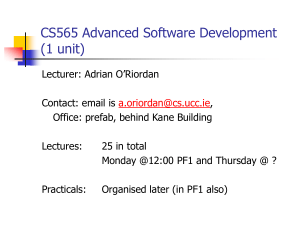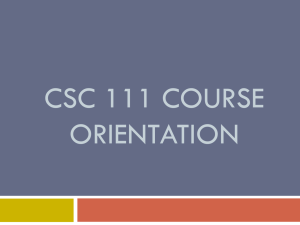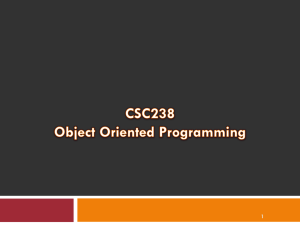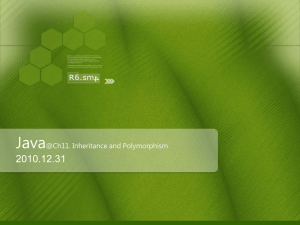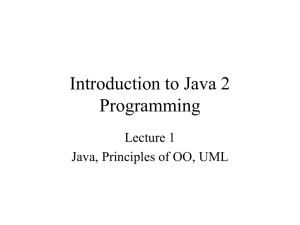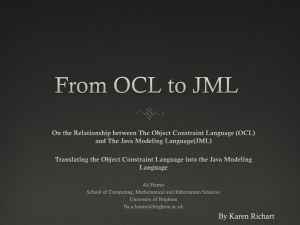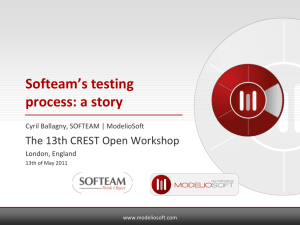ppt
advertisement
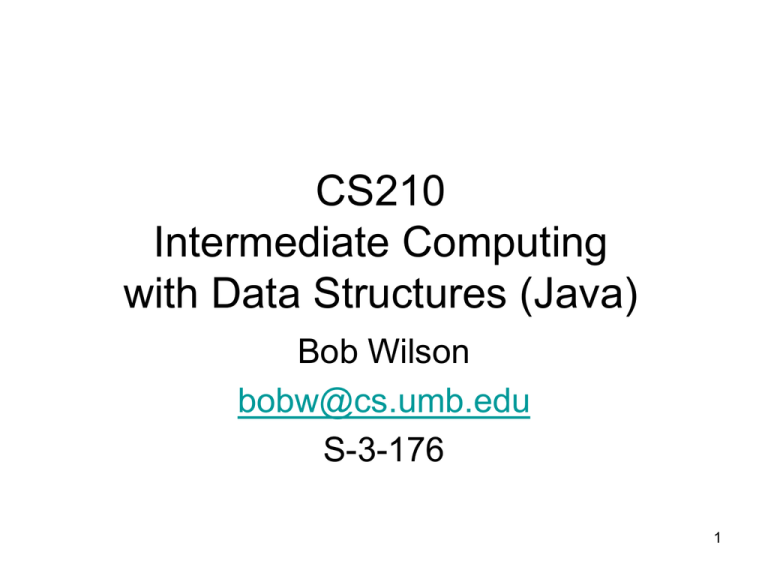
CS210
Intermediate Computing
with Data Structures (Java)
Bob Wilson
bobw@cs.umb.edu
S-3-176
1
Prerequisites
• We expect that you already know the Java
programming language at an introductory
level (usually gained by taking our CS110
or CS 114L/115L)
• You should be capable of writing a program
with at least two Java classes from scratch
• If you can not, you should NOT take this
course. See your advisor for other options
such as retaking CS110 or taking CS119
2
Welcome to CS210
• Textbook is Lewis and Chase, Java Software
Structures, 4th Ed.
• The course syllabus is on CS210 website:
http://www.cs.umb.edu/~bobw/CS210/index.html
• Go to the UNIX/PC lab (Science Bldg 3rd floor)
– “Apply” for a UNIX/PC account and/or add CS210
– You need that account to upload your project files
• We’ll go through the syllabus now
3
Course Procedures
• Two lecture sessions each week
– Held in this classroom
– Slides and demonstrations, but no hands-on
• I recommend that you print copies of my
lecture notes and bring them to each lecture
• One lab session each week
– In one of the Healey Library General Use Labs
– Hands-on work associated with the lectures
– Lab report must be turned in the following week
4
Homework Assignments
• Reading for this class: L&C 1.1, App A
• Reading for next class: L&C App B
– I will briefly review this material next class
– I assume that you are already familiar with the
Java programming language
– You are responsible for it in homework or exams
– If you are not familiar with it, please see me!
• Lab 1: Read assignment for next week
5
Software Development Methods
• Classical “Waterfall” Development Steps
Edit and save
source code
Errors
Build source code
to create program
Errors
Run program and
evaluate results
6
Errors
• A program can have three types of errors:
• The IDE editor and/or compiler will find syntax errors and
other basic problems (compile-time errors)
– If compile-time errors exist, an executable version of the program
is not created
• A problem can occur during program execution, such as
trying to divide by zero, which causes a program to
terminate abnormally (run-time errors)
• A program may run, but produce incorrect results,
perhaps using an incorrect formula (logical errors)
7
Unified Modeling Language (UML)
• UML is a graphical tool to visualize and
analyze the requirements and do design of
an object-oriented solution to a problem
• Three basic types of diagrams:
– Use Case Diagram
– Class Diagram
– Interaction Diagram
• A good reference is UML Distilled, 3rd Ed.,
Martin Fowler, Addison-Wesley/Pearson
8
Unified Modeling Language (UML)
• Advantage of UML – It is graphical
– Allows you to visualize the problem / solution
– Organizes your detailed information
• Disadvantage of UML – It is graphical
– Can be done with pencil and paper – tedious!
– Commercial UML S/W tools are expensive!
• Example: Rational ROSE (IBM acquired Rational)
– We have UMLPAD which is a simple design
tool to aid in drawing UML diagrams
9
Use Case Diagrams
• Typically the first diagrams drawn
• Helpful for visualizing the requirements
• Icons on the Use Case Diagram
– Actors: Users or other external systems
– Objects: Potential classes in the solution
– Scenarios: Sequences of interactions
between Actors and Objects that are typical
for the solution to the problem (Both success
cases and error cases should be included)
10
Example: Use Case Diagram
“No Sale”
<<includes>>
Customer
Cry over lost
commission
Bartender
Stiff Drink
Buy with Cash
Process
Cash Sale
Cash
Register
Sales Person
Buy On Credit
Product
Cash
Process
Credit Sale
Bank
Credit Card
Card Swipe
Machine
11
Class Diagrams
• Classify the Objects in the Use Cases
• Define name of each class
• Define each class’s attributes
– Constants
– Variables
• Define each class’s behaviors
– Methods
• Show relationships between classes
– Depends on, Inherits, etc.
12
Example: Class Diagram
Credit Card
- myCardData : CardData
Bank
- name : String
- address : String
- accounts [ ] : AcctData
+ read( ) : CardData
CardData
- cardType : enum {Visa, …}
- myBank : Bank
- myAcctNumber : int
+ processCharge (
thisCardData : CardData
amt : double,
storeName : String,
storeBank : Bank,
storeAcctNumber : int
) : boolean
AcctData
+ getCardType( ) : enum
+ getBank( ) : Bank
+ getAcctNumber( ) : int
-acctLimit : double
-acctBalance: double
…
13
Interaction Diagrams
• Shows the time relationship of the events
in a scenario between actors and objects
– UML Sequence Diagram
– Sometimes called a “ladder diagram”
• A vertical line represents an actor or object
• A horizontal line represents an interaction
– E.G. a call to a method of another object
• Progress of time is shown down the page
14
Example: Interaction Diagram
Process Credit Sale
Time
Sales
Person
Card Swipe
Machine
swipeCard( )
Credit Card
Bank
read( )
return CardData
enterAmt(…)
processCharge( … )
return boolean
readResponse( )
return “OK”
15
Software Development Tools
• Using Sun Java SDK alone
Command Line Interface
Programmer
Editor
Source
File(s)
(.java)
Compiler
(javac)
Class
File(s)
(.class)
Virtual
Machine
(java)
Program
executes
Parts of Sun Java SDK
16
Using Sun Java SDK Alone
• Example DOS Commands and Parameters
C:\ > edit HelloWorld.java
(Create/edit “source file” in an external window)
C:\ > javac HelloWorld.java (creates .class file)
C:\ > java -classpath … HelloWorld
Hello World
C:\ > exit
17
Software Development Tools
• We will use a combination of the Dr Java IDE
and the Sun Java SDK
Graphical User Interface
Dr Java IDE
Edit
Build
Run
Source
File(s)
(.java)
Compiler
(javac)
Programmer
Class
File(s)
(.class)
Virtual
Machine
(java)
Program
executes
Parts of Sun Java SDK
18
On-line Demonstration: Dr Java
19
Software Development Tools
• Download/install the software development
tools on your own PC if you wish to do your
project assignments at home
– Sun Software Development Kit (SDK)
– Dr Java Integrated Development Environment
(IDE)
• Use the PCs in the Healey Library labs as
they already have these tools installed
20
